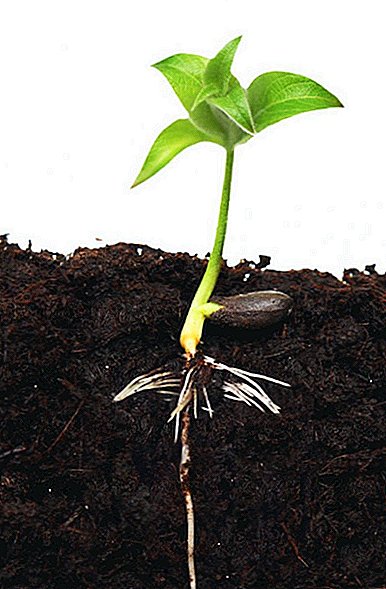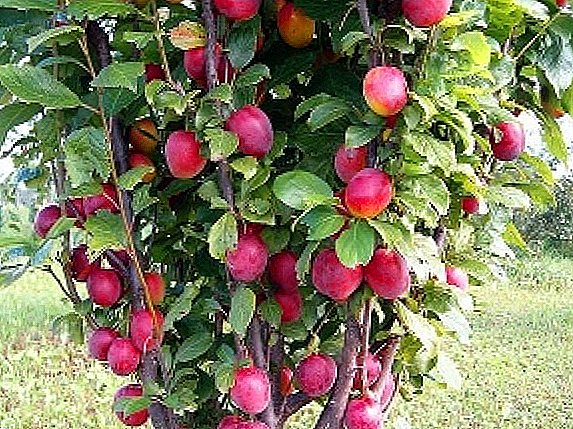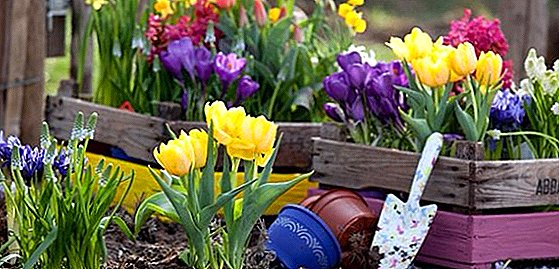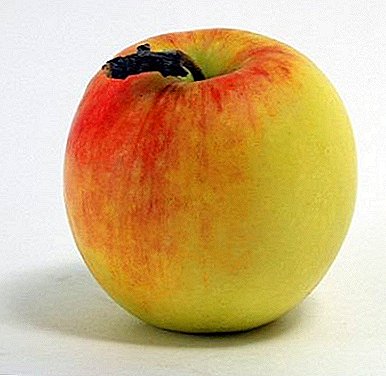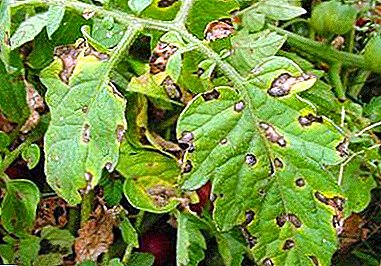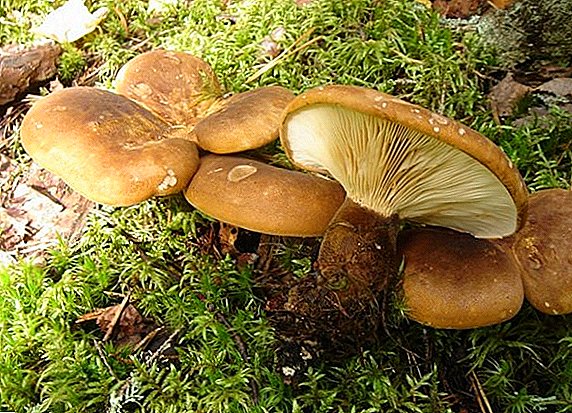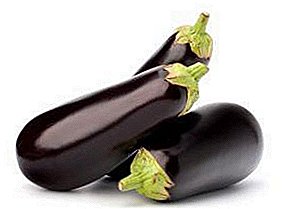
Eggplants are close relatives of tomatoes and potatoes. Grow in Moldova, Transcaucasia, Ukraine, in the southern regions of Russia, as well as in Central Asia. In the food they use the fruits of the plant. Eggplants canned, boiled, stewed, pickled, cooked caviar from them. Dishes from them are nourishing and very helpful.
What is useful eggplant?
Eggplants contain vitamins of group B, vitamin PP, ascorbic acid, potassium, phosphorus, calcium, magnesium, iron, sodium. Minor quantities contain manganese, copper, aluminum, zinc, cobalt.
Eggplants, thanks to their pectin and targonic acids, potassium salts, contribute to the removal of cholesterol from the blood, as well as the cure of atherosclerosis. Contribute to the normalization of the liver. In terms of their calcium content, they are superior to pumpkin, carrot, onion, pepper, melon. They have a mild diuretic effect.
Learn how to grow cucumbers in the open field at your site.
Here in detail about the secrets of planting fruit trees.
Technique of theft from bees //rusfermer.net/bee/rabota-s-pchelami/podkormka-pchel/podkormka-pchely-vorovki.html
Basic requirements for soil for growing eggplant
Eggplants love fertile soil. Therefore, when digging the soil in it add organic and mineral fertilizers. If the soil is fertile by itself, then only humus and mineral fertilizers are added to it. Eggplants grow well on light soil. On heavy soils compact bushes are formed, and this is not always good for the plant.
Eggplant has a very powerful root system. It is during fertilizer application that the emphasis is on potassium. With a weak development of the stems of the plant, it is necessary to increase the proportion of nitrogen twice. The rate of soil acidity is 6.5-7.2. from a lack of magnesium in the soil, the plant can develop poorly, so you need to monitor its presence in it.
Eggplant. Growing from seed
 Eggplants tolerate transplantation rather poorly, as this process suffers from its root system. It is recommended to grow seedlings directly in peat pots, not subjecting them to pickling. If you still have to dive plant, then this should be done with utmost caution.
Eggplants tolerate transplantation rather poorly, as this process suffers from its root system. It is recommended to grow seedlings directly in peat pots, not subjecting them to pickling. If you still have to dive plant, then this should be done with utmost caution.
Growing seedlings eggplant and care for her
At 10-15 days after planting, eggplant seeds are already sprouting. Growing seedlings without picking takes 40-45 days; when picking - 50-60 days. For good seed germination, the plant requires an air temperature of 22-26 degrees Celsius. When the first shoots appear, the temperature is lowered to 13-16 degrees Celsius. This contributes to the proper development of the root system, they become strong, and the shoots are not stretched. After five or six temperatures should be increased to plus 20-25 degrees. This temperature must be maintained until planting in the ground. Immediately before planting, the plant should be hardened by the sun. To this end, the eggplant seed pots are put out in the sun for 10-15 minutes. This should be done within two or three days two or three times.
Planting eggplant seedlings in open ground
 Before planting seedlings in open ground, the plot is first marked and made holes (planting grooves). At the same time, the distance between rows should be 45-50 cm, between plants directly in the row - 25-30 cm. Water from one to three liters should be poured into the prepared wells. In the moistened well immediately planted seedlings. Then the wells are covered with dry earth. This contributes to good rooting of seedlings, as well as its survival. Watering seedlings should be carried out every two to three days.
Before planting seedlings in open ground, the plot is first marked and made holes (planting grooves). At the same time, the distance between rows should be 45-50 cm, between plants directly in the row - 25-30 cm. Water from one to three liters should be poured into the prepared wells. In the moistened well immediately planted seedlings. Then the wells are covered with dry earth. This contributes to good rooting of seedlings, as well as its survival. Watering seedlings should be carried out every two to three days.
Growing eggplant and care for them
Growing and caring for eggplant is feeding, watering and processing from weeds.
Dressing eggplant
During the growth of the plant make 3-5 dressings. Two to three weeks after planting the seedlings make the first feeding. Eggplants do not require an earlier feeding, since their root system is still poorly developed, which is still unable to absorb useful elements.
Before the appearance of the fruit, fertilizing is carried out by mineral complex fertilizers. When the fruit appears, fertilizing is carried out with nitrogen-phosphate fertilizers: in 10 liters of water, one tablespoon of superphosphate and one teaspoon of ammonium nitrate is diluted. For better dissolution of superphosphate in water, it is best to draw a hood from it. Organic fertilizers promote the growth of plant stems, so they need to be applied in moderation.
Bioud - organic fertilizer, made on the basis of mullein and recommended for use by many gardeners. Bred it in the ratio of 1:20.
Organic and mineral supplements should be carried out alternately. To stimulate the growth of eggplant should be a 12-15 day after planting make root dressing. During the fruiting eggplant, it is recommended to sprinkle the soil with ashes. If the plant does not bloom well, then it is sprayed with bonic acid, which is dissolved in hot water. The excess green mass of the plant indicates a lack of potassium in the soil, poor plant development - a lack of nitrogen. Foliar nutrition of the plant with microelements is carried out in wet and cool weather.
Watering eggplant
 Watering the plants is best done regularly, since eggplant is a moisture-loving crop. The lack of moisture leads to the fall of the fruits and flowers of the plant, as well as to stop the development. Water eggplant should be warm water. Water temperature should be at least 20 degrees. After planting seedlings in the ground, eggplant is first watered on the fifth day. After watering is carried out once a week. If the weather is hot and dry, watering should be made more frequent. Water the plant under the root so that the stems and leaves remain dry.
Watering the plants is best done regularly, since eggplant is a moisture-loving crop. The lack of moisture leads to the fall of the fruits and flowers of the plant, as well as to stop the development. Water eggplant should be warm water. Water temperature should be at least 20 degrees. After planting seedlings in the ground, eggplant is first watered on the fifth day. After watering is carried out once a week. If the weather is hot and dry, watering should be made more frequent. Water the plant under the root so that the stems and leaves remain dry.
Processing eggplant
Processing culture involves loosening between rows and weed control. Eggplant - thermophilic culture. Therefore, during the growing season it is necessary to carry out the frequent cultivation of row spacing. It promotes good soil warming. The process of loosening between rows for the season is repeated 4-5 times. The nature of the soil as well as weather conditions can affect the frequency of tillage. The first loosening of inter-rows should be carried out to a depth of 8-10 cm, subsequently - 10-12 cm. The quality of the soil affects the depth of loosening. In wet and dense soil, the first loosening is carried out to a depth of six to eight cm on the third day after planting, later on by 8-12 cm.
Buying and transporting bees is all about the most favorable period for buying bees.
And here //rusfermer.net/bee/info/biology/stroenie-pchely.html you will learn all the most valuable things about the structure of the queen bee.
Growing eggplant in open field
As soon as the height of the stem in medium and vigorous varieties of eggplant has reached 30 cm, the plant must be tied up. This should take into account the fact that the plant will still grow, and the thickness of its stem will also increase. Therefore, when tying up, leave a reserve for the plant. During development, eggplants form three stalks. As soon as the first and strong lateral shoots of the eggplant were formed, they should be tied to a trellis. The process is repeated two or three times a week. It depends on the growth of the plant. The remaining side shoots with a height of less than one meter should be removed. This process is the most difficult and monotonous. Additional shoots in the summer and you can leave, but it will reduce the growth rate of the plant, and also lead to the formation of additional fruits. In order to reduce the "thickening" of the plant, two small leaves are removed near its tops.
Other plant formation work:
- nipping secondary flowers;
- deliverance of the fetus from the petal ring.
These works reduce the appearance of gray rot. To reduce the density of the leaves, they should be cut. The appearance of secondary shoots should be immediately removed.
 Low-growing varieties of eggplant and hybrids in the care is much easier. At the beginning of the development of the plant, two or three of the strongest side shoots are selected, and the rest are removed. All shoots and leaves are also removed from the main stem. Shrubs are cleaned from yellowed and diseased leaves, as well as from deformed fruits. At the end of the season you need to pinch the top of the stems, leaving five to seven small ovaries. Also removed at the end of the season and appearing on the plant flowers. Strict adherence to these techniques allows you to get good and large fruits. Removal of flowers from the plant in no way leads to changes in the total yield.
Low-growing varieties of eggplant and hybrids in the care is much easier. At the beginning of the development of the plant, two or three of the strongest side shoots are selected, and the rest are removed. All shoots and leaves are also removed from the main stem. Shrubs are cleaned from yellowed and diseased leaves, as well as from deformed fruits. At the end of the season you need to pinch the top of the stems, leaving five to seven small ovaries. Also removed at the end of the season and appearing on the plant flowers. Strict adherence to these techniques allows you to get good and large fruits. Removal of flowers from the plant in no way leads to changes in the total yield.
I would like to draw your attention to the fact that when growing a plant one should not blindly follow all the above instructions. It is best to observe the plant and its development. This will help you better understand exactly what he lacks precisely at one time or another of his development. And the result of your observations and labors will be a high-quality, useful and big harvest.


 Learn how to grow cucumbers in the open field at your site.
Learn how to grow cucumbers in the open field at your site. Buying and transporting bees is all about the most favorable period for buying bees.
Buying and transporting bees is all about the most favorable period for buying bees.